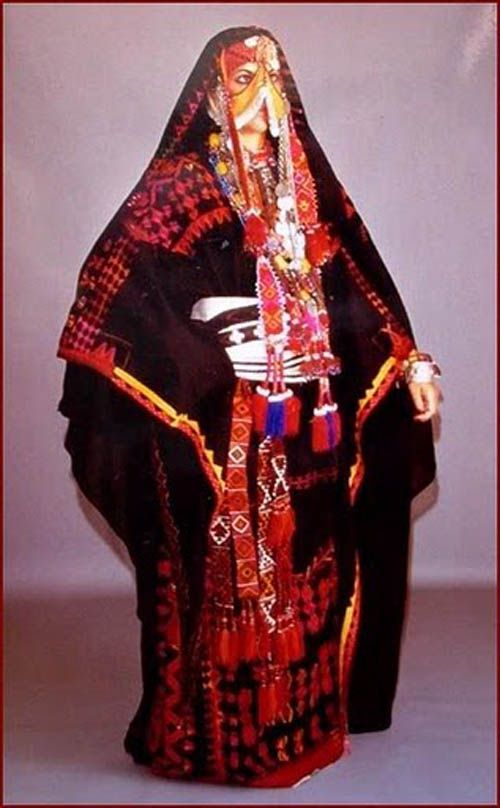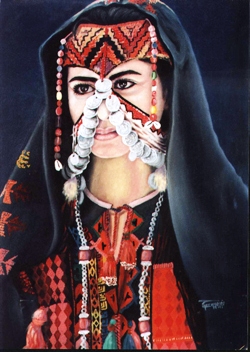Traditional Jordanian Dress
The traditional costumes worn by Jordanians and represent an important part of the history, identity, culture and cultural production of the Jordanian people over the centuries. Despite jordan's relatively small size, Jordanian
fashion is characterized by its originality and very diverse, especially women, due to the diversity of Jordan's geography, where each region has its own designs and some costumes and commonalities between some regions. These costumes
are also characterized by their elaborate handicraft and decorations based on Jordanian history, beliefs and the environment.
Men Dress
Popular costume for Jordanian men
- Capers or capbaz or dashdash
- Damer
- Abaya
- Serwal
sewed from white rose cloth and riding on the edges of the white wheat and called the Chinese dome and decorated with qaitan and close sized the neck.
A coat that reaches below the waist and is worn in the summer with a head dress (case) made of soft georgians worn on the sides and (aqal) made of goat hair and called "al-Maraz" but in winter phelps (capers) with (damer) made of canvas with bright colors.
A loose robe with light colors in summer and dark in winter and made of beauty and is light and loose and with wide sleeves and sometimes worn by the man on the shoulders.
A wide, loose white trouser made of linen that is tied to a man's bottom and a wide shape from the top to the waist.

The dress of the head
- shamag
- Al-Aqal
- Al-Jannad
its color red and white and it is fringed with white cotton threads and is worn in a way that is cursed or responds from one side on the head and leaves the other on the shoulder.
A table of black goat hair called "Al-Maraz's head" is worn on top of the shamagh and boasted by Jordanian men.
A belt attached to the chest in a hard or single form, which is made of black leather and has pockets in which bullets are placed or gun monnet in addition to a purse attached to the side of the waist and keeps the gun and from the other end (shari'a), which is used to slaughter sheep and indicates the generosity of the Arab man as well as used for self-defense or hunting in the desert, grazing or in cases of guarding.

Women Dress
Popular costume for Jordanian women
- "Malas" or "Abu Ruisha"
- Madraqa
- Abu Drine
- A babi dress
- Shoihi
The dress of the body consists of a long black dress.
the Women wear it above the previous dress that is embroidered with blue-colored filaments and usually embroidered by hand or black and black and from the shape of the dresses.
is sleeveless and wears a sleeve shirt underneath.
it is three folds and resembles a celtic dress (16 arms) and the wearing of the damir al-Jukh, so the woman wears it above the guardianship and is also called (squatter) and made by hand.
One of the women's distinctive costumes is a belt called "Shoihi", a satin silk woven from which the spruce hangs up the knee and this belt has almost disappeared.

The dress of the head
- AlOsba
- Al-shonbor
- Al-Orja
- Al-Saffa
- Al-Bashkir
It is a piece of silk with gold or silver reed or both, red, black and can be dark, pink or orange. It is embroidered in the form of a rectangular belt of the head and connects on top of the forehead. They range in length from one and a half to four metres.
also called a Mandeel ,It is a multi-colored cloth, the most famous black and white, or cut in both colors, damaged on the head before placing the band on the forehead and the stench may be long to reach the lower back.
It is a gold piece that arrives with a zigzag of small beads with bright colors and is also placed in the front of the head and is a small beads with bright colors that the Jordanian woman places in a zigzag form, hence she took her name (limp),attached to it pieces (liras) of gold, and placed in the front of the head and extends back down and worn only brides and married brides in weddings.
It is like Al-Orja from the front, but it does not extend to the back and is devoid of beads, where it describes the coins on a cloth decorated with embroidery, and is worn only by married women
A small handkerchief with bright colors decorated with flowers and nets on its limbs, spread in the ramtha area and worn over the schnair. At the end of the 1940s, a large number of Ramtha residents emigrated to West Germany and brought handkerchiefs similar to the Jordanian peshmerga used to call it the German Peshmerga.


